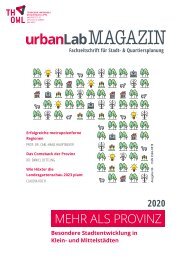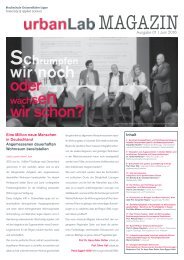urbanLab Magazin 2021 - Transformation
Erfolgreiche ePaper selbst erstellen
Machen Sie aus Ihren PDF Publikationen ein blätterbares Flipbook mit unserer einzigartigen Google optimierten e-Paper Software.
in 2 directions with hydraulic jacks. The<br />
distortion was increased in 5mm steps<br />
up to 70mm in both directions. As a result<br />
no failure of any kind was found<br />
up to the max. distortion which was<br />
~2.5 times greater than predicted in the<br />
structural analysis.<br />
As the glass panes are basically only<br />
supported on two sides and glass had<br />
to be designed as accessible for maintenance<br />
and cleaning, design criteria similar<br />
than outlined in ASTM E 2751 have<br />
been chosen. The glass analysis showed<br />
that some load cases were close<br />
to the limits; so another small mockup<br />
has been build simulating a worst case<br />
maintenance load case.<br />
One representative glass pane with<br />
a makeup of 2*12mm HS glass and a<br />
1.52mm DG41 interlayer was installed<br />
with actual project details on a sub frame;<br />
temperature was increased to 50°C<br />
and kept on that level for the entire test.<br />
Loads were applied at the most critical<br />
location on a surface area of 4 in²; loading<br />
was increased from 50lbs to 300lbs<br />
and kept for 10 minutes. When no failure<br />
of any kind was discovered, the test<br />
has been repeated a) with a broken upper<br />
glass bane and b) with a broken upper<br />
and a broken lower glass pane. As<br />
a result the cracks in the glass basically<br />
had no visible impact on the performance<br />
of the glass; no major deflection<br />
etc. have been discovered.<br />
When all tests have been passed the<br />
loading was further increased to 825<br />
lbs – when the weights tumbled over<br />
and massively damaged the glass. However<br />
it was found that no weights fell<br />
through the glass and no harmful glass<br />
parts fell out of the laminate.<br />
Cable Clamps The diagonal twin cables<br />
of the dome structure are clamped each<br />
time they pass a node of the primary<br />
dome structure. The individual segments<br />
of the cables will receive uniform<br />
pre-tension during installation, but as<br />
soon as the scaffolding is released, and<br />
especially in wind scenarios, parts of<br />
the dome geometry are deforming in a<br />
rhombic shape, explained in the section<br />
above. The diagonal twin cables, which<br />
counteract this rhombic distortion, will<br />
receive increased axial tension forces at<br />
areas of the dome where the structure<br />
deforms most. This creates changing<br />
cable forces from one segment to the<br />
other. The differential value of tensile<br />
force is carried by the cable clamp. The<br />
clamps are therefore an essential member<br />
of the structural system.<br />
APPLIED IDEAS<br />
43
















